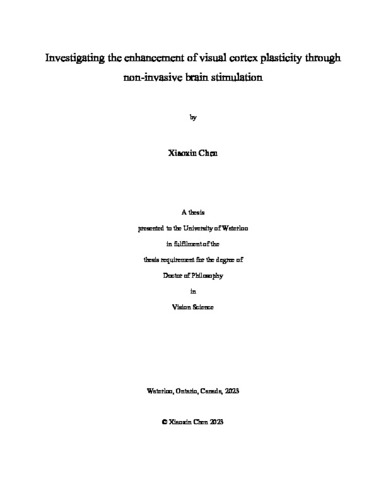| dc.contributor.author | Chen, Xiaoxin | |
| dc.date.accessioned | 2024-01-02 19:44:09 (GMT) | |
| dc.date.available | 2024-01-02 19:44:09 (GMT) | |
| dc.date.issued | 2024-01-02 | |
| dc.date.submitted | 2023-12-07 | |
| dc.identifier.uri | http://hdl.handle.net/10012/20201 | |
| dc.description.abstract | Purpose: (1) To investigate the effects of various non-invasive brain stimulation (NIBS) modalities, including high-frequency transcranial random noise stimulation (hf-tRNS), anodal transcranial direct current stimulation (a-tDCS), and repetitive transcranial magnetic stimulation (rTMS), on short-term ocular dominance plasticity in adults with normal vision; (2) To probe the neural mechanisms underlying short-term ocular dominance plasticity using NIBS techniques; (3) To explore the state-dependency of NIBS within the visual cortex; (4) To evaluate the efficacy of a novel ocular dominance test (the letter-polarity test) as a tool of measuring ocular dominance shifts following monocular deprivation (MD).
Methods: Three studies using hf-tRNS, a-tDCS and rTMS were conducted. NIBS was delivered to V1 during MD. The primary outcome was ocular dominance shift, measured through two ocular dominance tests, a traditional binocular rivalry test and the letter-polarity test, before and after the interventions. Secondary outcomes included mixed percept durations and alternation rates as provided by the binocular rivalry test. The reliability of the letter-polarity test was evaluated in comparison to the binocular rivalry test through a comprehensive set of analyses.
Results: (1) In three studies, short-term ocular dominance plasticity was observed as a shift in ocular dominance towards the deprived eye. (2) No significant effects of NIBS were observed on the primary and secondary outcome measures. (3) By comparing the effect of 120-minute MD and 30-minute MD, we observed a significantly smaller magnitude of ocular dominance shifts with 30-minute MD. (4) The reliability of the letter-polarity test was similar to that of the binocular rivalry test.
Conclusions: These experiments suggest that the neural mechanisms underlying short-term ocular dominance plasticity in adults with normal vision may be more complex than a simple reduction in cortical inhibition. It may be necessary to reconsider the cortical site responsible for this plasticity and the neuromodulatory effects of NIBS on visual cortex activity. Our null findings of NIBS effects may also be explained by a different cortical activation state induced by MD. These findings provide valuable reference points for future studies investigating the enhancement of visual cortex plasticity. | en |
| dc.language.iso | en | en |
| dc.publisher | University of Waterloo | en |
| dc.title | Investigating the enhancement of visual cortex plasticity through non-invasive brain stimulation | en |
| dc.type | Doctoral Thesis | en |
| dc.pending | false | |
| uws-etd.degree.department | School of Optometry and Vision Science | en |
| uws-etd.degree.discipline | Vision Science | en |
| uws-etd.degree.grantor | University of Waterloo | en |
| uws-etd.degree | Doctor of Philosophy | en |
| uws-etd.embargo.terms | 0 | en |
| uws.contributor.advisor | Thompson, Benjamin | |
| uws.contributor.advisor | Bobier, William | |
| uws.contributor.affiliation1 | Faculty of Science | en |
| uws.published.city | Waterloo | en |
| uws.published.country | Canada | en |
| uws.published.province | Ontario | en |
| uws.typeOfResource | Text | en |
| uws.peerReviewStatus | Unreviewed | en |
| uws.scholarLevel | Graduate | en |

